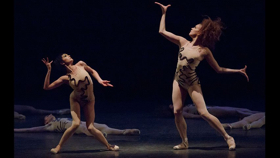Review: ROBBINS 100, New York City Ballet's Homage to the Co-Founding Choreographer

New York City Ballet's Centennial Celebration at the Koch Theater in Lincoln Center of the 100th anniversary of Jerome Robbins' birth honors the prodigiously gifted dancemaker, the company's Co-Founding Choreographer, with a ballet lover's feast of six programs from May 3rd to May 20th 2018. The run includes two world premieres as well as 20 ballets by Robbins. He died in 1998 at the age of 80, but "Robbins 100" shows beyond a doubt that his legacy endures.
The first program, "Tribute to Robbins", began on May 3rd with NYCB's spring gala and was repeated through May 13th. Following that, the centennial offers "All Robbins No. 1", "All Robbins No. 2, "All Robbins No. 3", "All Robbins No. 4", and "All Robbins No. 5". Click here to see the full list of ballets and credits.
On the evening of Friday, May 11th, I thoroughly enjoyed the varied quintuple bill of "All Robbins No.3" that showcased Robbins' versatility, musicality, and innate sense of humor. First up was Interplay to a jazzy and often joyous score by Morton Gould dating from 1945 and originally entitled "American Concertette". The ballet had its premiere 73 years ago in 1945 at the Ziegfield Theater, yet its charm is as fresh today as ever. The titles of the four sections will give you an idea of what a delightful romp this is: I. "Free Play", II. "Horseplay", III. Byplay, IV. Team Play. The theme is a good-natured competition that had the dancegoers laughing out loud at times.
The second offering was Robbins' 1970 In the Night with pianist Nancy McDill skillfully playing the music of Chopin as three couples danced under what looked light a starlit sky. Each pair conveyed distinct emotions about their relationships and all came together at the end in an otherworldly andante to "Nocturne Op. 9, No. 2" in rondo form. All of the dancers were superb: Emilie Gerrity and Chase Finlay, Maria Kowrowski and Russell Jansen, and Sara Mearns and Jared Angle. There was a heartbeat of hushed silence in the audience at the end before a burst of well-deserved applause.
After an intermission, the second half of the program opened with what the Playbill described as a "musical exploration of the score for The Cage by Igor Stravinsky." The 1946 masterpiece is Concerto in D for String Orchestra. The New York City Ballet Orchestra's string sections were raised up from the pit to the audience's eye level and Associate Music Director Andrews Sill led a fascinating lesson,called "See the Music . . ." after the famous Balanchine quote "See the music, hear the dance." The musicians played excerpts to illustrate various concepts such as the buzzing sound of the violas. Sills averred that this audio effect may have inspired Robbins to create his ballet about the feral instinct of insects that drives females of a species to view the males as prey. After the musicians were lowered back down into the pit, the eerie and compelling ballet began with Sterling Hyltin as The Novice, Savannah Lowery as The Queen, Justin Peck and Sean Suozzi as the hapless male victims, and a corps of women as creatures executing innovative bug-like movements. The Playbill quotes Robbins as having said, "I did not have to confine myself to human beings moving in a way that we know is human. In the way their fingers worked, in the crouch of a body or the thrust of an arm, I could let myself see what I wanted to imagine."
In striking contrast to The Cage and once again displaying Robbins' remarkable range, the next offering was Other Dances to the music of Chopin played beautifully on stage by pianist Elaine Chelton. Robbins created this ballet for the legendary Russian dancers Mikhail Baryshnikov and Natalia Makarova who defected to America to grace our stages with their astounding gifts not only for technique but also for stage presence. At the performance on May 11th, Tiler Peck and Joaquin de Luz more than held their own as they followed in the footsteps of that legendary duo. The choreography utilizes not only classical ballet but also character dance, the theatricalized versions of folk dances that Russians in particular do so well. I was especially delighted by the mazurkas. However, the entire work dating from 1976 is a treasure.
The closer after another intermission was Robbins' 1953 Fanfare to Benjamin Britten's 1945 "Young Person's Guide to the Orchestra" on a theme by Henry Purcell. The Major Domo, in this case the actor David Aaron Baker, narrates in booming tones while the dancers representing the instruments of the four families of the orchestra perform the choreography that gives each instrument a personality - often a comical one. This ballet is not only entertaining but also educational. How wonderful that it remains in the NYCB repertoire!
You still have time to catch the rest of "Robbins 100". Don't miss it!
Photo by Paul Kolnik
Add Your Comment
Play Broadway Games
Videos





%20(1024%20×%20512%20px).png)
